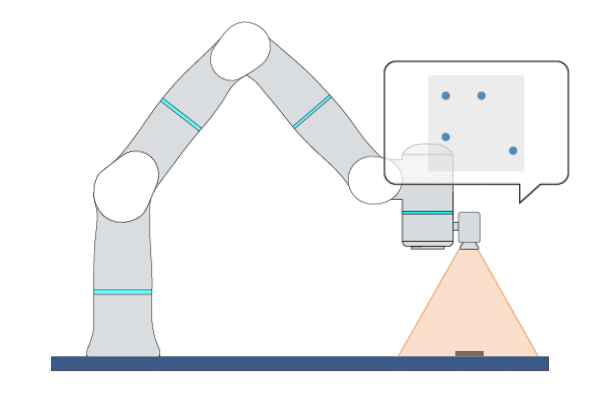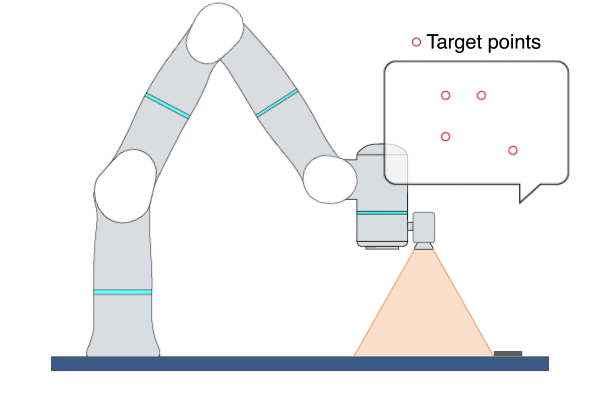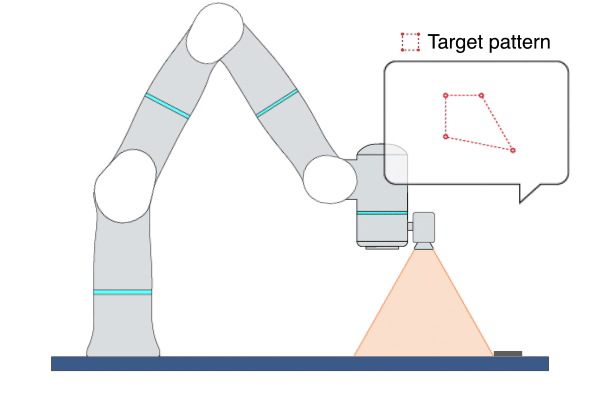Visual Servoing
TeachFeature

Primitive Description and Usage
Description: This primitive collects image feature data from AI multiple times and outputs their average value.
Example Usage: Move the robot to the target position and use this primitive to record the target image features. You can save the values of the output parameters in the variables, and use them later in other primitives under the Visual Servoing category.
Primitive Input Parameters
Input Parameter |
Description |
Type |
Unit |
Default Value & Range |
|---|---|---|---|---|
objName* |
Object name used by AI |
OBJNAME |
none |
|
objIndex |
Object index used by AI |
INT |
none |
0 ∈ [0 … 1] |
collectTimes |
Number of times AI collects image feature samples |
INT |
none |
30 ∈ [10 … 200] |
*Parameters marked with an asterisk must be assigned a value prior to executing the primitive.
Primitive State Parameters
State Parameter |
Description |
Type |
Unit |
|---|---|---|---|
terminated |
The termination flag of the primitive. It is set to true if the primitive is terminated. |
BOOL |
none |
timePeriod |
The time spent on running the current primitive. |
DOUBLE |
s |
Primitive Output Parameters
Output Parameter |
Description |
Type |
Unit |
|---|---|---|---|
tcpPoseOut |
The TCP pose when the primitive is terminated. It is represented in the world coordinate system. |
COORD |
m-deg |
taughtFeaturePoint |
Position of the taught feature points in the image coordinate system. Its value can be used in input parameter [targetFeaturePoint] in primitive [AlignPoint] and input parameter [targetFeaturePattern] in primitive [AlignPattern]. |
ARRAY_VEC_2d |
none |
taughtFeaturePointNoise |
Noise of the taught feature points. Its value can be used in input parameter [visualDetectNoise] in primitive [AlignPoint] and [AlignPattern]. |
ARRAY_VEC_2d |
none |
taughtMatchPoint |
Position of the taught feature points of the aligned object in the image coordinate system. Its value can be used in input parameter [alignObjPoint] in primitive [AlignPoint]. |
ARRAY_VEC_2d |
none |
taughtFeatureLine |
Position of the points on the taught feature lines in the image coordinate system. Its value can be used in the input parameter [targetFeatureLine] in primitive [AlignLine]. |
ARRAY_VEC_2d |
none |
Default Transition Condition
State Parameter |
Condition |
Value |
|---|---|---|
terminated |
= |
1 |

AlignPoint

Primitive Description and Usage
Description: This primitive uses Image-Based Visual Servoing (IBVS) to move the robot continuously based on real-time visual feedback to align the feature points on the target object with the user-defined feature points.
Example Usage: Use this primitive to control the robot to grasp an object whose position is uncertain or changing. This primitive can be used to align two objects, such as aligning a PFC cable with a socket.
Primitive Input Parameters
Input Parameter |
Description |
Type |
Unit |
Default Value & Range |
|---|---|---|---|---|
targetFeaturePoint* |
Position of the target feature points in the image coordinate system. Each point is represented by two pixel values (X, Y). |
ARRAY_VEC_2d |
none |
|
targetDepth* |
Depth of target feature points in the image coordinate system |
ARRAY_DOUBLE |
m |
[0.01 … 1.2] |
motionAxis |
Axes that are allowed to move in the image coordinate system |
VEC_6i |
none |
1 1 1 0 0 1 ∈ [0 0 0 0 0 0 … 1 1 1 1 1 1] |
maxVel |
Maximum linear velocity of robot movement |
DOUBLE |
m/s |
0.05 ∈ [0.001 … 0.5] |
maxAngVel |
Maximum angular velocity of robot movement |
DOUBLE |
deg/s |
20.0 ∈ [1.0 … 100] |
velScale |
Velocity scale of visual servoing. Caution: Setting this value too large may cause robot vibration. |
DOUBLE |
none |
10 ∈ [1.0 … 100.0] |
imageConvToler |
Convergence tolerance of visual servoing. When the error between the captured image features and the target features is within tolerance, it will be determined that they are aligned. |
DOUBLE |
none |
2.0 ∈ [0.2 … 20] |
objName* |
Object name used by AI |
OBJNAME |
none |
|
objIndex |
Object index used by AI |
INT |
none |
0 ∈ [0 … 1] |
enableObjAlign |
Flag to enable the object alignment function. This function can be used to align the feature points of two objects. |
BOOL |
none |
0 ∈ [0 / 1] |
alignObjPoint |
Position of feature points of aligned object in the image coordinate system. Each point is represented by two pixel values (X, Y). The aligned object is in the robot hand and is moved by the robot. |
ARRAY_VEC_2d |
none |
|
optVelScale |
Increase the velocity scale of visual servoing in the Z and Rz directions. It can help optimize the robot’s Cartesian motion trajectory. |
VEC_2d |
none |
5 5 ∈ [1.0 1.0 … 100 100] |
visualDetectNoise |
Noise of the visual detection result of each feature point |
ARRAY_VEC_2d |
none |
[0 0 … 20 20] |
*Parameters marked with an asterisk must be assigned a value prior to executing the primitive.
Primitive State Parameters
State Parameter |
Description |
Type |
Unit |
|---|---|---|---|
terminated |
The termination flag of the primitive. It is set to true if the primitive is terminated. |
BOOL |
none |
timePeriod |
The time spent on running the current primitive. |
DOUBLE |
s |
featureAligned |
Flag to indicate if the maximum pixel error between target feature points and detected feature points is within tolerance |
BOOL |
none |
Primitive Output Parameters
Output Parameter |
Description |
Type |
Unit |
|---|---|---|---|
tcpPoseOut |
The TCP pose when the primitive is terminated. It is represented in the world coordinate system. |
COORD |
m-deg |
Default Transition Condition
State Parameter |
Condition |
Value |
|---|---|---|
reachedTarget |
= |
1 |

AlignPattern

Primitive Description and Usage
Description: This primitive uses Image-Based Visual Servoing (IBVS) to move the robot continuously based on real-time visual feedback to align the feature patterns on the target object with the user-defined feature patterns.
Example Usage: When the pattern features (such as rectangles) on the object are obvious, use this primitive to control the robot to align the object to the target position via visual servoing. It is recommended to use this primitive in applications that require more than 4 degrees of freedom alignment.
Primitive Input Parameters
Input Parameter |
Description |
Type |
Unit |
Default Value & Range |
|---|---|---|---|---|
targetFeaturePattern* |
Position of points on the target feature pattern in the image coordinate system. A pattern consists of several points. Each point is represented by two pixel values (X, Y). |
ARRAY_VEC_2d |
none |
|
targetDepth* |
Depth of target feature points in the image coordinate system |
ARRAY_DOUBLE |
m |
[0.01 … 1.2] |
motionAxis |
Axes that are allowed to move in the image coordinate system |
VEC_6i |
none |
1 1 1 0 0 1 ∈ [0 0 0 0 0 0 … 1 1 1 1 1 1] |
maxVel |
Maximum linear velocity of robot movement |
DOUBLE |
m/s |
0.05 ∈ [0.001 … 0.5] |
maxAngVel |
Maximum angular velocity of robot movement |
DOUBLE |
deg/s |
20.0 ∈ [1.0 … 100] |
rectangleFeature |
Flag to indicate if the feature pattern is rectangle |
BOOL |
none |
1 ∈ [0 / 1] |
velScale |
Velocity scale of each axis in the image coordinate system for visual servoing. Caution: Setting this value too large may cause robot vibration. |
VEC_6d |
none |
15 15 15 3 3 15 ∈ [0.0 0.0 0.0 0.0 0.0 0.0 … 100 100 100 100 100 100] |
imageConvToler |
Convergence tolerance of visual servoing. When the error between the captured image features and the target features is within tolerance, it will be determined that they are aligned. |
DOUBLE |
none |
5.0 ∈ [1 … 200] |
objName* |
Object name used by AI |
OBJNAME |
none |
|
objIndex |
Object index used by AI |
INT |
none |
0 ∈ [0 … 1] |
*Parameters marked with an asterisk must be assigned a value prior to executing the primitive.
Primitive State Parameters
State Parameter |
Description |
Type |
Unit |
|---|---|---|---|
terminated |
The termination flag of the primitive. It is set to true if the primitive is terminated. |
BOOL |
none |
timePeriod |
The time spent on running the current primitive. |
DOUBLE |
s |
featureAligned |
Flag to indicate if the maximum pixel error between target feature points and detected feature points is within tolerance |
BOOL |
none |
Primitive Output Parameters
Output Parameter |
Description |
Type |
Unit |
|---|---|---|---|
tcpPoseOut |
The TCP pose when the primitive is terminated. It is represented in the world coordinate system. |
COORD |
m-deg |
Default Transition Condition
State Parameter |
Condition |
Value |
|---|---|---|
reachedTarget |
= |
1 |
